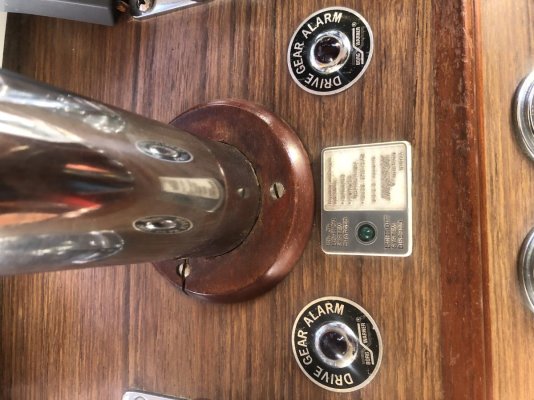Capt. Rodbone
Senior Member
- Joined
- Sep 6, 2020
- Messages
- 172
- Location
- U.S.
- Vessel Name
- SV Stella Polaris MV Sea Turtle
- Vessel Make
- 1978 VanDine Gaff rigged schooner, 1978 Grand Banks Classic Trawler
Grand Banks 42 Classic..Twin Lehman 120’s and Berg Warner Velvet Drive Trannys
Late yesterday pulling into a transient slip dead downwind, two boat lengths to go and sun setting directly over my bow greatly limiting my visibility from the fly bridge, I have a buzzer start going off. First thought was I’d lost an engine. But quickly learned I had not. Think I recall looking at both oil pressure and water temp gauges but can’t be sure it all happened so fast. As soon as I learned I still had power we were entering the slip anyway. Once in the slip with a dockhand aspiring my wife with lines I went below. I think I noticed the lights on the drive train indicators on, but it could have been the glare coming straight in on the dash. I shut everything down. Within a few minutes I was below checking the fluid in both transmissions. That seemed fine. I decided to read up and learn what I could and deal with it this morning. As I was starting to do so my next slip neighbor was by his rail and as we talked he said he is a retired marine mechanic and was curious about any lights or audible alarms with a Velvet drive transmission because he’d worked on many and had never seen that. He came onboard and said that buzzer was likely something else and maybe it was the glare on the lights because the transmission shifts fine and sounds fine when I started it. I didn’t check the fluid in it yesterday afternoon because I understand it you should do so immediately after shut down? If so, now I’m wondering if it reaches operating temperature just in the slip? Thinking maybe we leave the slip and just stay close by and shift in and out and let all systems get to operating temperatures and see what happens. Interestingly, I am reading in the manual on a troubleshooting chart that says regulator valve buzz. Could that be what I was hearing? If so, it says two possible causes are low oil level and regulator valve, stuck so polish it with crocus cloth to remove burrs and clean. Could that be what I was hearing, and if so, how could a mechanic who has worked on many of these not know about an audible or light alarm? just looking for guidance on how I should proceed to make sure I don’t have an issue. Mostly, I suppose how do you suggest I prep the transmissions to make certain I have the proper level of fluids in each?
Late yesterday pulling into a transient slip dead downwind, two boat lengths to go and sun setting directly over my bow greatly limiting my visibility from the fly bridge, I have a buzzer start going off. First thought was I’d lost an engine. But quickly learned I had not. Think I recall looking at both oil pressure and water temp gauges but can’t be sure it all happened so fast. As soon as I learned I still had power we were entering the slip anyway. Once in the slip with a dockhand aspiring my wife with lines I went below. I think I noticed the lights on the drive train indicators on, but it could have been the glare coming straight in on the dash. I shut everything down. Within a few minutes I was below checking the fluid in both transmissions. That seemed fine. I decided to read up and learn what I could and deal with it this morning. As I was starting to do so my next slip neighbor was by his rail and as we talked he said he is a retired marine mechanic and was curious about any lights or audible alarms with a Velvet drive transmission because he’d worked on many and had never seen that. He came onboard and said that buzzer was likely something else and maybe it was the glare on the lights because the transmission shifts fine and sounds fine when I started it. I didn’t check the fluid in it yesterday afternoon because I understand it you should do so immediately after shut down? If so, now I’m wondering if it reaches operating temperature just in the slip? Thinking maybe we leave the slip and just stay close by and shift in and out and let all systems get to operating temperatures and see what happens. Interestingly, I am reading in the manual on a troubleshooting chart that says regulator valve buzz. Could that be what I was hearing? If so, it says two possible causes are low oil level and regulator valve, stuck so polish it with crocus cloth to remove burrs and clean. Could that be what I was hearing, and if so, how could a mechanic who has worked on many of these not know about an audible or light alarm? just looking for guidance on how I should proceed to make sure I don’t have an issue. Mostly, I suppose how do you suggest I prep the transmissions to make certain I have the proper level of fluids in each?

